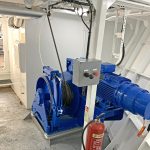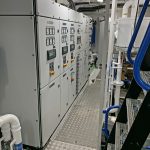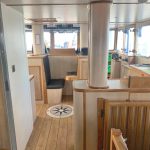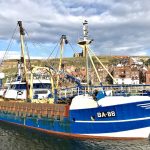Skippers Jamie Clarke and Scott Bremner and the crew of the 34m Alcedo are highly impressed with the level of performance delivered by the beam scalloper in the first month of fishing, reports David Linkie.
After Alcedo landed her maiden five-day trip into Hartlepool at the end of March, West Coast Sea Products donated the first £1,000 of her catch to Captain Tom Moore who, by walking 100 lengths of his garden before celebrating his 100th birthday, had raised over £28m for NHS charities as Fishing News went to press.

Built to Class, Alcedo features a customised layout and specification.
Built to a high level of technical specification, Alcedo incorporates a number of new ideas developed through close collaboration between the owners’ experienced team, designer SC McAllister, Parkol Marine Engineering and other main suppliers.
West Coast Sea Products Ltd started discussions on building Alcedo four years ago.
Initiated by John King, MD of the well-known family-owned Kirkcudbright scallop-processing and vessel-owning company, the aim of the project was to replace the 47-year-old 32.5m beam scalloper Albatross BA 88 with a modern equivalent incorporating the latest technology, to provide enhanced levels of catch quality, fishing and crew safety and fuel efficiency.
Four years is a long time, particularly given the major national issues that have occurred since 2016, but it highlights the timescale required to draw up and finalise plans for a new style of vessel and see a build slot materialise into a practical reality.
The end result, Alcedo BA 77, represents a highly significant achievement for West Coast Sea Products and Parkol Marine Engineering.
Designed to give optimum levels of efficiency for both king and queenie scalloping, Alcedo features bespoke gear- and catch-handling systems, electric-drive main winches operated through an advanced regenerative power management system, and a customised internal layout in which the accommodation cabins are situated on the main deck.

10t derrick winches driven by 30kW motors are housed in separate main deck compartments in the fo’c’sle.

Pullmaster 3t tugger winches supplied by EK Marine are mounted on the shelterdeck at the base of the lifting gantry.

Alcedo lifting her scallop dredges for the first time, before running off to carry out fishing trials.

The outer hull tipping doors are raised by three hydraulic rams.

Grated walkways are positioned inboard of the side conveyors.

Looking down on the side hoppers and main deck.

Prime king scallops in the reception hoppers.

Lifting the dredges before raising the tipping doors.

The Mitsubishi S12R MPTAW main engine and Reintjes 11.919:1 reduction gearbox.

A Mitsubishi S6A3 driving a 540kVA generator is run when hauling the gear.

A 185kVA Leroy Somer generator is driven by a Caterpillar C7.1 auxiliary engine.

The main electrical cabinets are positioned across the fore end of the engineroom.

An air-cooled Mitsubishi S4K 70kVA genset is housed in the fo’c’sle.

General view looking forward in the wheelhouse…

… and across the main display console.

Alcedo’s main forward scalloping…

… and side consoles.
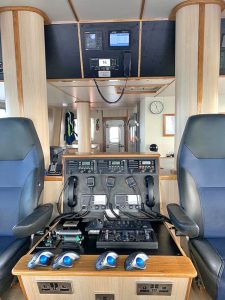
The Navitron autopilot and VHF sets are built into the central island console.
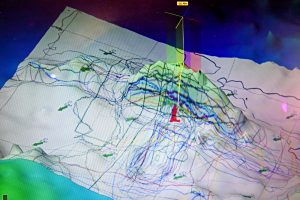
The FishingWin pre-mapped 3D seabed charts produced by Seafield Navigation enable skippers to visualise the bottom contours of new ground from the first tow.

Alcedo towing the dredges on the surface.

A Palfinger rescue boat and 6m folding gangway supplied by MMG Welding of Killybegs are secured on the shelterdeck abaft the wheelhouse.

Built to Class, Alcedo features a customised layout and specification.
Having a registered length above 24m required Alcedo to be built to Class in accordance with the globally recognised regulations specified by the International Association of Classification Societies, rather than Seafish rules. Accordingly, the design and build process was monitored throughout by Bureau Veritas as the certifying authority, which also carried out the plan approval.
Requiring high levels of technical capability and detailed knowledge of the rules, Class specifications are very stringent and all-encompassing, including stipulated grades of steel, coded welding that is fully documented, and 12-hour vessel endurance sea trials.
Of 34m LOA, Alcedo is the biggest new boat to have been built by Parkol Marine Engineering, and is also the biggest vessel to be built in the UK for 20 years. That the vessel was rolled out of Parkol’s extensive fabrication premises at Middlesbrough and lifted into the river Tees virtually ready to steam to Whitby for completion and fishing trials illustrates the benefits of the company expanding its operational bases to include a second facility.
Further evidence of this was provided by the fact that Alcedo sailed on her first trip from Whitby just three days before the 18.9m vivier-crabber Osprey WK 4 cleared the pier ends to head home to Scrabster. Completing two new builds within a week indicates how far Parkol Marine Engineering has come since the company built its first new boat, the under-10m scalloper/trawler Jacqueline Anne OB 555, in 1997.
While Alcedo was fishing her third trip in the North Sea before landing into Peterhead at the beginning of last week, John King said: “Keeping up with the times is an important consideration in any business. West Coast Sea Products took delivery of its last new boat, the 21.3m beam scalloper King Challenger, in 2006.
“Since then, scallop fishing has continued to evolve, as have crew requirements and regulations. Alcedo is therefore designed to be suitable for fishing in all areas around the UK, with optimum levels of operational efficiency, safety and crew comfort.
“Although there is seldom such a thing as a right time to order a new vessel, given the long lead-in period to taking delivery of it, at some point you have to take the plunge.
“Ordering Alcedo was clearly a very big and difficult decision to take, not least because Brexit is still ahead of us, hence an unknown quality.
“Consolidating supplies of king and queen scallops for processing by West Coast Sea Products in Kirkcudbright lies at the heart of the company’s business, and therefore is of paramount importance. Landings from King Challenger BA 87, King Explorer BA 829, Kingfisher BA 810, the Eurocutter Osprey BA 4, previously skippered by Jamie Clarke [Mobile Shellfish Fisherman of the Year winner at the Fishing News Awards 2019], and now Alcedo – which is the Latin name for ‘kingfisher’ – form the main source of supply for West Coast Sea Products Ltd.
“In terms of design, build quality, engineering and internal finish, Alcedo is everything we hoped for and more. Skippers Jamie Clarke and Scott Bremner and crew are delighted with how efficient the boat is to work, and after some poor weather they encountered towards the end of the first trip, are extremely impressed by her seakeeping capabilities, which they describe as phenomenal.
“Credit for this goes to designer Ian Paton for the divergent thinking he put into delivering our requirements. Building Alcedo has been an interesting challenge, to which many people’s experience contributed. The end result bears testament to their efforts, and particularly to those of Parkol Marine Engineering, who were excellent to work with.”
Insured by Maritime International Solutions, Alcedo will usually work six- to seven-day trips before landing into the nearest convenient port, from where scallops will be delivered by refrigerated truck to Kirkcudbright for processing by West Coast Sea Products.
General layout
Of round bilge hull form, Alcedo has main dimensions of LOA 34m, registered length 29.95m, beam 8.9m, moulded depth 4.67m, draught 4.6m and GT 350t.
From the outset, enabling Alcedo to have a maximum draught of 4.8m when necessary was a key requirement, in order to ensure a viable measure of practical highwater access to Kirkcudbright’s tidal harbour.
This requirement – which was achieved by incorporating two trim tanks aft and one in the forepeak, thereby enabling the aft draught to be reduced when approaching and leaving harbour on the river Dee – imposed constraints on the hull design. As a result, Alcedo features a near-horizontal traditional plate keel.
Although of similar length to her predecessor Albatross, Alcedo has 1.5m more beam, in order to give enhanced space throughout the vessel and underwater hull displacement, and therefore achieve the desired layout.
Buoyancy tanks, in the form of sealed voids built into the sides of the hull from deck level to just below the gunwale rail, extend the full length of the working deck. Replicating the benefits associated with a watertight shelterdeck, these give greater angles of stability by compensating for the reduction in GZs and righting levers when free water comes on deck, thereby enhancing the already rigorous stability criteria required by beamers.
Alcedo features an interestingly different internal layout, custom-designed to deliver optimum levels of practical operational efficiency, together with crew comfort and safety.
From forward, the hull below the main deck is divided by watertight bulkheads into forepeak trim tank, central thruster compartment flanked by deep fuel tanks port and starboard, lower workshop, fishroom, engineroom, and aft store/steering gear compartment located between the port and starboard trim tanks.
Parallel-sided along its full length, and with none of the usual terracing, Alcedo’s fishroom, which has an approved design capacity for 60t, is an integral part of the vessel’s design. GRP-lined throughout to ensure ease of cleaning and therefore maximum hygiene, the fishroom includes two tiers of flush anchorage points along either side, to which strops are attached to give secure catch storage throughout a trip.
The clean rectangular interior of the fishroom, which standardises storage of 0.5t dumpy scallop bags, is made possible by the fact that two deep fuel tanks are positioned between the sides of the hull on either side of the fishroom. Representing an integral part of the vessel’s 64,700-litre fuel capacity, this arrangement ensures that Alcedo remains on a constant even trim during a trip, with the increasing catch weight compensating for the amount of fuel used. It also maximises the effectiveness of the fore and aft trim when accessing Kirkcudbright harbour.
On the main deck, arrangements from forward are fo’c’sle housing chain locker, derrick winch compartments, workshop (starboard) and emergency fire pump/harbour genset room (port), hardwood-sheathed working deck and deckhouse.
Positioned between the side catch conveyors, the narrower forward section of the deckhouse is accessed from the main deck through a central passageway, on either side of which are separate compartments housing the main split trawl winches. These are located forward of a large deck clothing room, which in addition to heated oilskin storage and bench seating, houses laundry facilities and the 230AC distribution cabinets for the electric winches. An enclosed deck toilet is also accessed from the deck wardrobe.
The main washroom lies to port of the next section of the central passageway, which also gives access to the wheelhouse, and the second shower is to port forward of the engine exhaust trunking.
The third door along the internal corridor in the deckhouse, which at this point extends to the hull sides aft of the catch conveyors, leads to Alcedo’s main accommodation areas.
Four two-berth cabins to starboard of the centreline are accessed from a transverse corridor. A single-berth skipper’s cabin is incorporated into the wheelhouse. Finished to a high level using light-coloured natural oak, all the internal accommodation areas are warmed by electric convection heaters.
An extensive galley, fitted with the usual range of electrical appliances, is arranged forward of the messdeck, in which horseshoe bench seating surrounds two tables.
The anchor winch, main trawl and derrick wire sheaves and a landing crane are mounted on the forward section of the shelterdeck. Grated walkways positioned above and inboard of the side conveyors join the whaleback, which runs either side of the wheelhouse above the catch conveyors before extending out to the hull sides at the aft end of the wheelhouse.
A Palfinger rescue boat and deck crane are positioned on the stern section of the shelterdeck, together with a cabinet housing survival suits, a 6m gangway supplied by MMG Welding Ltd of Killybegs, and the customary mooring rope ponds.
Scalloping arrangements
Scalloping activity on Alcedo is based around the beams mounted at the base of the truncated A-frame main gantry positioned amidships just forward of the wheelhouse, and outer hull tipping doors pivoted on top of the bulwarks that extend up to the level of the shelterdeck.
Alcedo’s scallop gear came from West Coast Sea Products’ in-house company store, Kirkcudbright Scallop Gear.
Jackson Trawls of Peterhead supplied 2 x 500m lengths of Bridon Dyform 32mm-diameter trawl wire.
The array of derrick stays came from Tyson’s Ships’ Riggers Ltd of Grimsby.
Dutch specialist Padmos manufactured the bespoke electric-drive main split trawl and beam winches, together with the associated electrical distribution boards, all of which were fully bench-tested at Stellendam before being delivered to Alcedo as the vessel was under construction on Teesside.
EK Marine of Killybegs supplied the balance of the deck machinery, including the hydraulically operated outer hull tipping doors, catch conveyor system, tugger winches, stiff-boom landing crane and winch (1t @ 10m), and anchor winch.
The decision to opt for electric-drive main winches was based on their well-proven quiet and smooth running characteristics, together with minimum service requirements.
The main winch system is fed via Alcedo’s 415V power supplies. Active front-end units convert the AC power to DC, smoothing the power ready to be used. Inverter drives then convert the DC power back to AC with the necessary voltage and frequency for the motors.
The use of the active front-end units greatly limits the total harmonic distortion and keeps the power factor as close to unity as possible. This ensures that the system is as efficient as possible.
When the winches pay out, the reverse rotation of the motor enables it to act as a generator. The electrical power produced by the motor is fed back to the ship’s 415V power supply to be used elsewhere on the vessel, thereby reducing load on the generators, and fuel costs.
Driven by 90kW motors, the main trawl winches have a capacity of 250 fathoms of 32mm-diameter wire and a bottom layer pull of 33t. The units are housed in dedicated rooms at the fore end of the deckhouse, from where the trawl wires have slightly elevated leads above the main deck forward to two horizontal rollers on the fo’c’sle, from where they lead outboard to a large towing sheave on the end of each beam.
Operated by 30kW motors, the 10t beam winches are mounted on the main deck forward, from where the 20mm-diameter wires lead directly upwards to vertical rollers on the whaleback, before leading aft inboard of the guard rail on the grating walkway to a floating sheave positioned at the base of the main gantry. The beams are raised and lowered by a five-purchase wire arrangement incorporating double sheaves to give maximum efficiency and smoother running.
All of the distinctive yellow-painted Flemings Fairleads blocks were manufactured by F&R Belbin of Whitley Bay.
Two hydraulically operated Rotzler 3t pull-down winches are positioned on the shelterdeck forward of the lifting gantry.
On being lifted to the straight gunwale rail amidships, the 17-a-side dredges are inverted by hydraulically operated outer hull tipping doors, allowing the contents to drop into receiving hoppers. Fitted into recesses along the vertical sides of the shelterdeck, these extend for more than half of the vessel’s length. Pivoted at shelterdeck level, the self-tipping doors are raised by three hydraulic rams mounted along the lower edge of the hull recesses.
The winches and tipping doors are operated from either forward or side consoles in the wheelhouse, where warp length gauges are also positioned.
The tipping doors and their operating system were supplied by EK Marine. To accommodate the bigger dredges used when fishing queenies, the doors were made deeper, at 1.2m, rather than the customary depth of around 1m associated with king scallop dredges.
As the dredges are hauled to the surface, the beams are raised until the tooth bars are level with the top of the tipping doors, and forward and aft short restraining chains are quickly clipped into purpose-made eyes welded onto each end of the towing bars to prevent the gear from swinging either inboard or outboard. As the doors are pivoted upwards through 180°, the dredges are held by teeth along the outboard edge of the doors, allowing the contents to descend into the side reception hoppers.
Independently operated forward and aft conveyors move scallops towards the middle of Alcedo, from where they are transferred to a shorter transverse conveyor leading inboard. Selected scallops are picked off the conveyor, while anything else left on falls off the inboard end into an overboard discharge chute positioned under the selection conveyor.
King scallops are subsequently delivered via a large-diameter plastic chute down to the hold for storage in dumpy sacks.
When Alcedo fishes queenies, shakers are secured on either side of the main deck under the conveyors. Selected queenies are then delivered to the fishroom for bagging via holding hoppers.
Bagged catches of scallops in Alcedo’s fishroom are kept in optimum condition during a trip by a box-cooled refrigerated blower system. Installed by Dutch specialist Promac BV, the freshwater-based system uses two fan-driven blower units to constantly circulate chilled air in the fishroom.
Flake ice from a 2.5t machine supplied by Sea Ice of Kilkeel is placed on top of the 0.5t bags of scallops.
Engineroom machinery
Alcedo features a particularly spacious engineroom. This reflects the fact that the accommodation cabins are situated above rather than below the main deck, and the absence of any fuel tanks in the engineroom. Daily service fuel tanks, together with separate engine and gearbox oil tanks, are arranged on the aft side of the bulkhead of the large aft compartment. As well as housing the AS Scan double ram steering gear, this also serves as an engineer’s store, with spares held in secure racks and shelves.
Supplied and commissioned by Padmos of Stellendam, Alcedo’s 12-cylinder Mitsubishi S12R MPTAW main engine develops 749kW @ 1,500rpm and is coupled to a Reintjes WGF 773 gearbox with a reduction ratio of 11.919:1 to turn a 2,750mm-diameter four-bladed propeller mounted in a bespoke nozzle, which was fabricated by the yard. Dedicated solely to propulsion duties, the main engine delivered an average top speed of 11 knots when operating at full speed during six-hour Class endurance trials.
Premier Engineering of Scarborough supplied the propeller shaft and stern tube. Lips deepwater seals were supplied by Padmos.
The centreline propulsion system is operated through one of three sets of Kobelt electronic engine controls strategically positioned in the wheelhouse.
The vessel’s main electrical power is provided by Mitsubishi and Caterpillar auxiliary engines running Leroy Somer 415/3/50 generators.
The bigger Mitsubishi S6A3 drives a 540kVA generator, while a Caterpillar C7.1 engine supplies 185kVA. The scalloper’s advanced power management system includes a wheelhouse control switch enabling the Mitsubishi to run when more load is on the system during hauling, before switching over to the Caterpillar unit at other times to reduce fuel consumption.
Cooling for all three engines is provided through NRF box coolers arranged across the fore end of the engineroom.
An air-cooled Mitsubishi S4K-based 70kVA harbour/emergency genset that also runs Alcedo’s emergency fire pump is housed in the fo’c’sle.
Two 45kW and one 22kW motors housed in the lower forward workshop space drive the hydraulics for Alcedo’s deck machinery, including the catch conveyors. Two compressors supplying the scalloper’s air system, including the break release for the winches, shaft brake and pneumatic deck tools, are also located in the lower workshop.
The general electrical cabinets were supplied by MJR Controls of Stockton. Alcedo was wired in-house by Parkol’s electricians and Kvasir of Newcastle.
An electrically driven 150kW bow thruster, supplied by the Dutch Thruster Group and housed in a dedicated compartment, is fitted to give maximum vessel manoeuverability in restricted areas.
Alcedo can start a trip carrying 64,700 litres of fuel, housed in a combination of six deep tanks (two forward and four either side of the fishroom), from which levels are electronically displayed in the wheelhouse.
A double bottom tank under the concrete floor of the fishroom allows 14,900 litres of freshwater to be carried.
Wheelhouse
On entering Alcedo’s wheelhouse for the first time, the immediate feeling is one of space and orderliness, enhanced by the same superb level of natural wood finish that is evident throughout the boat.
Two Norsap seats flank a relatively small central island unit that leaves large areas of clear space adjacent to the side windows for watching the gear when hauling and shooting.
A single-berth skipper’s cabin, in which a desk and sink are also fitted, occupies the aft port quarter of the wheelhouse.
Four companies from North East Scotland, Woodsons, Furuno UK, Seafield Navigation and SIRM UK, supplied the comprehensive selection of electronic equipment. The flush-mounted Neovo X series glass-fronted displays for this are positioned on two levels in the main console, or directly overhead. The double-tier arrangement is separated into two halves by a central console, from which all gear-handling operations can be controlled.
Duplicate deck machinery and engine/steering controls are also located on either side of the wheelhouse.
The importance of scallop skippers being able to visualise both the composition and the shape of the seabed is reflected by the state-of-the-art seabed plotting systems and underwater acoustic sounding equipment installed on Alcedo.
Two TimeZero V4 plotters give a fully loaded professional fishing plotter system integrated into the latest Furuno radars, high definition CHIRP sounder and wind sensor.
This arrangement enables the skippers to incorporate the units into the TimeZero features, as well as utilising their stand-alone capabilities – i.e. using radar with chart overlay on TimeZero with the 2D/3D chart/navigational system, and using TimeZero to display the DFF1 UHD wind sensor/weather forecast up to 14 days in advance on the TimeZero plotters. Two TimeZero plotting systems also provide back-up redundancy.
Seafield Navigation supplied a FishingWin (formerly Sodena) plotting system with pre-mapped 3D high-resolution seabed charts from Shetland south to the French coast. Incorporating more than a billion soundings and representing a five-year initiative by Seafield Navigation, pre-mapped charts enable skippers to fully visualise new grounds from the first tow, without the need for a vessel to build up historical evidence.
Enabling skippers to work new grounds and customise tows in relation to ground edges, gullies and peaks, the FishingWin system also gives the facility to track the ends of the scallop beams.
Forward underwater vision is provided by a Furuno CH-250 Black Box sonar with high-definition active colour matrix, operating on 60kHz.
Alcedo’s Olex 2D/3D plotting system was supplied and installed by Woodsons.
Vertical sounding is performed by a Furuno FCV-1900 BB sounder giving high-definition echos, and a Furuno DFF1-UHD CHIRP unit is interfaced to give hardness mapping on the TimeZero plotting systems.
The main Furuno FAR-2218 BB 12kW radar is supported by a DRS4D NXT solid-state unit, the dome for which is mounted on the foremast.
Details of Alcedo’s location and heading are processed by two Furuno GP-32 receivers and a Furuno SC-70 satellite compass.
Vessel steering and navigation are taken care of by a Navitron NT 921G digital autopilot system.
Communications equipment includes a Furuno FM-8900 GMDSS VHF, two Sailor 6210 VHFs, Furuno LH-5000 loudhailer/intercom, Furuno NX-700B Navtex receiver, Jotron TR8000 Class A AIS and Sailor 600 Ka internet communications system. Alcedo’s satellite TV package came from SIRM UK.
Woodsons installed a comprehensive CCTV system deploying 12 cameras and four AG Neovo X24 glass-fronted wide screens. An underwater hull camera covers the propeller, nozzle and rudder area.
Teamwork delivers
Although it was possible to drive to Whitby to photograph Alcedo leaving for fishing trials a few days before the government imposed the lockdown to combat the Covid-19 pandemic, these measures prevented the opportunity to take onboard photographs before the scalloper sailed on her maiden trip.
Texts for help immediately produced positive responses, followed by the photographs that made this feature possible.
Sincere thanks to everyone who helped so readily, despite the operational difficulties they themselves were facing – particularly skipper Jamie Clarke for scaling the heights.























